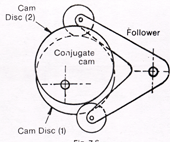Manufacturing of tank by rolling and welding:
Three roll benders work by "pinching" the flat work piece between two rolls and bending it as it comes in contact with a forming roll. This bends the work piece into a cylindrical form, where it is welded together to produce a cylinder. The upper roll is in a fixed position; the lower roll has adjustable movement to perform the gripping function. These are the "pinch" rolls. The third roll (the forming roll) is also adjustable. With a manually or hydraulically moved drop hinge, the top shaft is raised to release the pressure on the rolled sheet and allow removal of the finished work piece, especially a completed cylinder shape that may have had it's seam welded while still on the machine. Note: Without a lot of skill, on 3 roll machines, it can be difficult to form metal into tubular shapes smaller than 3 times the upper roll diameter when forming near capacity thickness and 1.5 times the upper roll diameter is often the tightest diameter using thinner and narrower metal. Results vary depending on metal thickness, width, and tensile strength.
Single-pinch (initial-pinch) machines require inserting the work piece into the machine twice in order to prebend both ends of a cylinder and ensure closure of the seam. To prebend the first end, the operator inserts the plate into the machine, which clamps it and pinches it between the top and bottom rolls. A side roll, moving diagonally toward the top roll, sets bend radius. The operator then removes the plate from the bender, rotates the plate 180 degrees to insert the second end into the rolls, then rolls the cylinder to completion. Recommended maximum thickness (or width instead) for prebending is usually 2/3 to 3/4 of the capacity of the machine.
Double pinch pyramid machines, also called three-roll double-pinch machines, can also prebend both ends of a plate with a single insertion into the bending machine, for reduction in material- handling time and cost. These machines can act as single-pinch machines or as pyramid machines, allowing the fabricator to select the best procedure for a particular job. The wide opening between the rolls allows short, heavy plate to be rolled. Double pinch-pyramid machines drive all three rolls, the top roll is fixed and the two lower rolls move in a straight path or an arc toward the top roll. This type of machine reduces the need for feeding the sheet through more than once.
On some machines, a cone shape can be formed by pre-cutting a flat metal blank with the correct inner and outer radius to form the cone (funnel) shape wanted. Usually the blank is fed on one side so that the inner radius rubs against a cone forming attachment. The bending roll position can sometimes be independently adjusted lower on one side to help.







